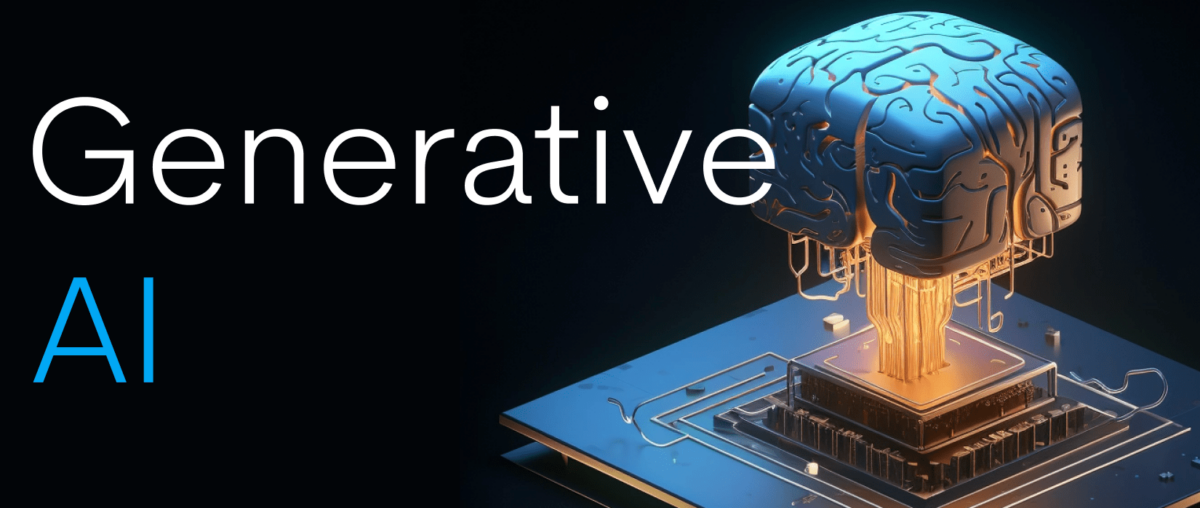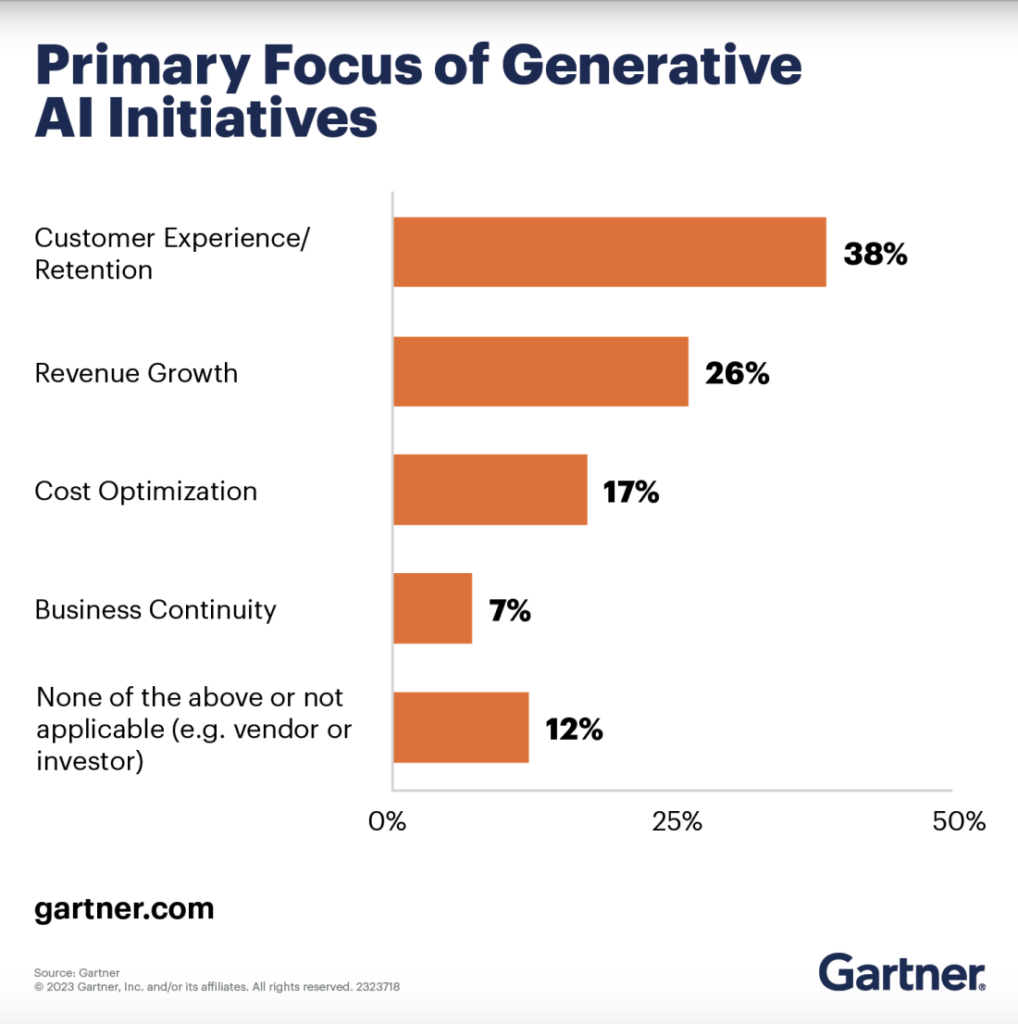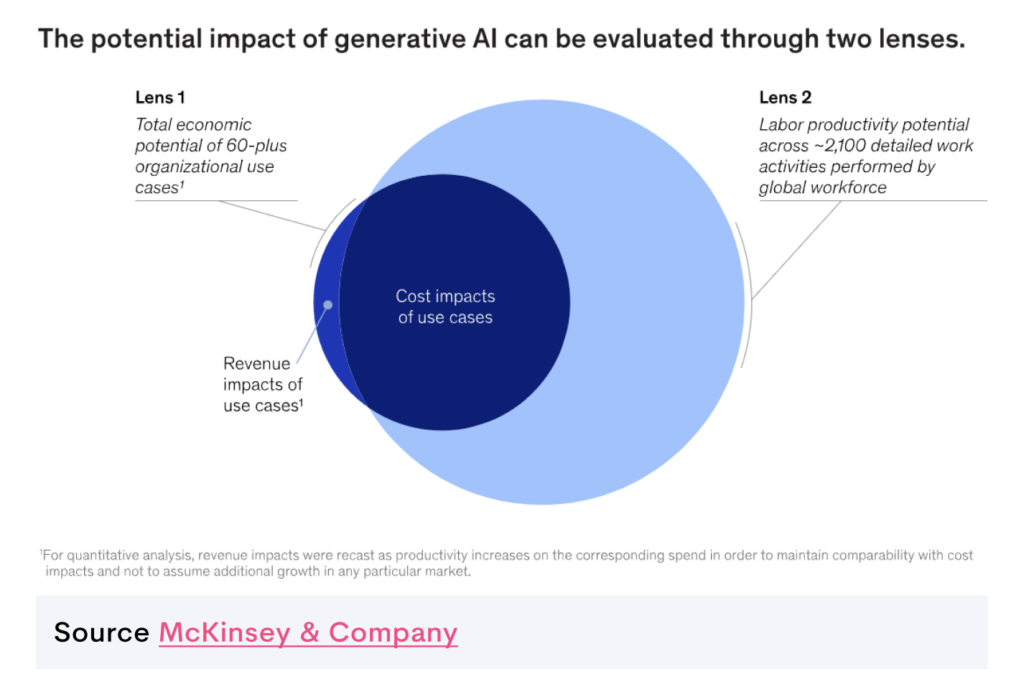Since November 2022, ChatGPT has dominated headlines. Businesses and investors rush to capitalize on the value of generative AI. According to McKinsey, GenAI has the potential to annually contribute $4.4 trillion in value across various domains. The best thing about this technology is that you can generate everything from texts and code to images, 3D objects, and videos.
Do you want to reveal your business potential with generated artificial intelligence? Today, we will talk about trends in the tech industry that will drive GenAI in 2024. Also, you will learn how technology influences sectors like fintech, healthcare, and renewable energy.

GenAI Recent Tech Trends
Today, commercial leaders feel the greatest influence of GenAI in such areas as lead identification (60%), marketing optimization (55%), personalized outreach (53%), content creation (50%), and analytics (45%).
But what GenAI technology latest trends will reshape the business and technology landscape in 2024? Here are the key tendencies, according to Forbes and other experts.

More Powerful Models
GPT-4 is reported to have one trillion parameters. Other Large Language Models (LLMs) like Google’s Gemini and DeepMind’s Gopher also contain hundreds of billions of parameters.
While there are other ways to enhance model performance (such as refining algorithms or improving training techniques), leveraging larger datasets and efficiently scaling the model size by utilizing architectures like Mixture Of Experts has been a dominant approach in recent advancements.

Electoral Interference
2024 is the biggest election year in history — people will cast votes for governments and parliaments in the USA, UK, Mexico, India, and dozens of other countries.
On the one hand, politicians and parties are likely to utilize this best tech trend for generating personalized campaign messages and emails. Conversely, deepfakes, increasingly realistic AI-generated content, are expected to play a role in deceiving the public. Tools based on LLMs might be employed to produce extensive propaganda, disrupting the political process by influencing opinions on a large scale.
Web3 x GenAI
Web3 is the next generation of the internet, emphasizing decentralized and user-centric principles. The convergence of Web3 and Generative AI technologies facilitates a personalized online experience and helps improve data security. This new tech trend is aimed at making it much harder for cyber threats to compromise user data.
High Demand for Prompt Engineers
Prompt engineers play a critical role in programming generative AI systems. They formulate the instructions in such a way as to maximize the optimal results from these systems. This top technology trend, the so-called “whisper of artificial intelligence,” helps companies achieve the best performance of systems, making them less complex, confusing, or intimidating.
Generative Design
Generative AI is leaving a larger product and service design footprint than other current tech trends. To receive blueprints and recipes, specialists just need to put requirements and materials. Platforms like Autodesk integrate GenAI, enabling designers to quickly generate digital twin prototypes. These prototypes can be tested in parallel, aiming for more robust, effective, and sustainable designs.

AI-Generated Video
We can’t deny the popularity of video content among younger generations. And it’s not surprising that AI toolmakers have swiftly responded to this trend tech, offering capabilities for video creation. Traditionally, producing such content was costly, requiring skilled professionals for creation, capture, and editing. In 2024, generative tools allow anyone to craft professional-looking content. Recent examples are SORA from OpenAI and Gen-2 from RunwayML.
AI-Generated Audio and Speech
AI-generated audio and speech are expected to become the latest tech trend, as common as AI-generated text and images were in the previous year. The robotic features and artifacts will disappear, and AI will be able to simulate the subtleties of human speech, including tone. As a result, it will be difficult to distinguish AI-generated audio content from human-generated speech. Latest research examples include models like Seamless Communication from Meta.
Multi-Modal Models
Like many other new trends in tech, GenAI has traditionally focused on simulating a single mode of expression, such as language, visuals, or audio. However, there is a notable shift towards “multi-modal” generative AI, where models can handle multiple forms of data simultaneously.
For example, OpenAI upgraded ChatGPT with voice and image features. GPT-4V manages image inputs. The mobile app now supports voice conversations with the chatbot.
Autonomous Generative AI
Autonomous GenAI continuously generates and responds to prompts, allowing them to perform more sophisticated operations than traditional agents. Unlike chatbots and other newest tech trends that respond to prompts and await further user instructions, autonomous generative AI like AutoGPT can carry out tasks autonomously.
In the future, artificial intelligence engineers will likely be working to create “generalized” AI that can be used for a variety of tasks without specific programming.
Generative AI-Augmented Apps And Services
Gartner predicts that approximately 40% of enterprise applications will incorporate conversational AI as a built-in feature to augment functionality and communication.

For example, major developers like Microsoft and Adobe actively incorporate business tech trends like chatbots and natural language interfaces into their platforms. Snapchat has introduced a generative AI bot into users’ contact lists, offering answers to queries or acting as a virtual companion.
GenAI in Fintech: Use Cases and Latest Technological Trends
The growing demand for personalized financial advice, rising fraud incidents, and the intricate market landscape have fueled heightened interest in Generative AI applications within other latest tech trends.
Banking is expected to be among the industries getting one of the most significant opportunities from GenAI — from $200 billion to $340 billion per year (9-15 % of operating profits), primarily driven by increased productivity. Notably, while initial GenAI focuses in banks centers on productivity, its transformative influence may extend to job roles, customer interactions, and innovative business models.
Let’s discuss common use cases of the latest trends in tech in detail.

Regulatory Compliance Assurance
Fintech has always been a highly regulated industry with an evolving compliance landscape. GenAI, among other trends tech, swiftly processes and interprets large volumes of regulatory information, facilitating timely identification of potential non-compliance areas.
By automating these tasks, GenAI minimizes human error and ensures a more consistent approach to regulatory compliance. Moreover, it provides real-time insights into regulatory changes, updates, and potential risks.
Fraud Detection & Risk Assessment
Conventional fraud detection methods are ineffective against today’s threats. At the same time, GenAI and other top tech trends give hope for safety. Analyzing transactional data in real time, it excels in identifying anomalies and patterns associated with fraudulent activities.
Another of GenAI’s strengths lies in its ability to adapt to evolving fraud tactics, leveraging machine learning to refine its models continuously. Its predictive capabilities contribute to more precise risk assessment processes in fintech.
Algorithmic Trading Optimization
Empower algorithmic trading by analyzing vast sets of market data. GenAI identifies hidden patterns and trends that may not be apparent through traditional analysis methods. Real-time information processing enables the execution of swift and informed decisions, giving traders a competitive advantage.
Credit Scoring Refinement
How to properly evaluate the creditworthiness of individuals with limited credit history or unconventional financial behavior? GenAI will come in handy in analyzing transaction history, spending behavior, and external factors. By considering a broader set of variables, GenAI leads to a more accurate and personalized credit scoring system.
Portfolio Management Assistance
GenAI analyzes market data, investment strategies, and risk factors to generate personalized portfolio recommendations. Considering diverse data points, it provides tailored investment advice aligned with individual preferences and market trends.
Smart Contract Implementation
Smart contracts are becoming more accessible. Generative AI streamlines their implementation by automatically generating code, analyzing existing contracts, and identifying security vulnerabilities. This enhances code quality, reduces development time, and ensures secure financial agreements.
Chatbots for Banking Services
AI-powered chatbots revolutionize banking services, providing 24×7 support, seamless account access, and transaction capabilities. Gen AI chatbots handle specific, non-pre-programmed queries like resolving fraudulent transactions where standard assistants or knowledge libraries might fall short. At the same time, its conversational abilities enhance customer service experiences, benefiting customers and service agents.
Financial Trends Forecasting
Need more accurate forecasting? The capabilities of Generative AI help predict market trends, identify investment opportunities, or assess potential risks. Furthermore, by continuously learning from new data and adjusting to dynamic market conditions, GenAI ensures that financial forecasts remain reflective of real-time insights.
Document Search and Synthesis
Stop wasting time on information search and synthesis. With GenAI, you can easily handle various document types, including contracts, policies, credit memos, underwriting documents, trading records, lending agreements, claims reports, and regulatory filings.
Gen AI accelerates economic data research and enhances analytical efficiency. At the same time, it assists corporate bankers in preparing comprehensive pitch books for engaging customer meetings.

GenAI in Healthcare: Use Cases and Tech Trends 2024
Gen AI is a powerful tool that can unlock a portion of the industry’s $1 trillion improvement potential. It achieves this by automating operational tasks, providing quick access to years of clinical data, and modernizing health systems infrastructure.

Predictive Analysis for Health Crises
During the COVID-19 pandemic, generative AI algorithms predicted the spread and impact of the virus. These models allow the discovery of new antibodies to infectious diseases, unraveling their origin and predicting reactions guided by the data.
Among other tech industry trends, generative AI provides powerful tools for risk prediction and mitigation, offering invaluable support in addressing and managing health crises effectively.
Personalized Treatment Protocols
Leverage GenAI algorithms to analyze patient data and generate tailored treatment protocols. In oncology, the technology delves into a patient’s genetic makeup to recommend the most effective cancer treatment, optimizing outcomes and minimizing side effects. Also, GenAI considers genetic mutations, past treatment responses, and current health status to formulate a personalized treatment plan.
AI Agents as Healthcare Assistants
Want a smart, AI-powered assistant? Such agents efficiently schedule appointments for chronic conditions, offer medical recommendations, and provide mental health support. This improves adherence to treatment plans, as patients actively participate in managing their health.
Population Health Management
Generative AI improves population health management by analyzing extensive datasets to identify health trends. Utilizing these predictions, public health campaigns can be tailored to encourage healthier lifestyles, effectively addressing and mitigating the burden of chronic diseases.
Medical Research and Simulations
Generative AI revolutionizes medical research, particularly in analyzing extensive biomedical data to uncover insights and generate hypotheses. It simulates disease progression in virtual models, providing researchers valuable insights for developing more effective treatments.
Healthcare Operations Optimization
What about predicting patient demand? This can be useful for optimizing staffing and managing medical supplies. For example, an AI model can accurately predict the demand for flu vaccines in a hospital during the winter, ensuring sufficient supply and minimizing wastage.
Generative AI can also predict the influx of patients during peak flu season. In this way, medical facilities adjust staffing levels to match the increased demand, ensuring the hospital is well-prepared and properly equipped. The result is increased patient satisfaction and safety.
Medical Note-Taking
The dream of doctors has already become a reality. Today, GenAI digitizes and streamlines medical records. For example, it can transcribe doctor-patient conversations in real time, ensuring accurate and comprehensive medical files. This way, physicians reduce time spent on administrative tasks and focus on patient care.
Drug Discovery and Development
Let generative AI analyze vast genetic databases to pinpoint potential drug candidates targeting specific genetic mutations responsible for disease. This targeted approach accelerates drug development and offers hope to patients facing limited treatment options. In addition, drugs become much more affordable for patients.

GenAI in Renewable Energy: Use Cases and Top Technology Trends
After an unprecedented year, the corporate procurement of renewable energy experienced a 31% growth in the number of transacting customers from the first half of 2022 to that of 2023. In 2024, major corporations are leveraging GenAI to meet and advance 24/7 and carbon-matching targets.
Big technology companies, accounting for a substantial portion of procured capacity, are expected to play a pivotal role in this trend. The training and utilization of GenAI could potentially significantly increase their data center’s demand for clean electricity.
Location Selection
Ensure your project is situated in areas with optimal conditions for harnessing solar, wind, or other renewable sources. Through sophisticated analysis of geographical data, climate patterns, and other relevant factors, GenAI assists in pinpointing locations with high energy generation potential. Thus, you can use resources more efficiently in the renewable energy sector.
Solar Panel Layout & Wind Blade Design
Optimize solar energy with GenAI using advanced algorithms for efficient solar panel layouts, considering sunlight exposure and geographical features. GenAI determines optimal blade configurations for wind turbine efficiency based on wind patterns and aerodynamics.
Energy Demand Forecasting
Through the analysis of historical energy consumption data, weather patterns, and other relevant factors, GenAI models help to generate accurate and dynamic predictions for future energy demand. This way, utilities and energy providers optimize resource planning and distribution strategies, ensuring efficient energy management.
Smart Grid Optimization
Use Gen AI to enhance the efficiency and reliability of energy distribution systems. Generative algorithms allow for analyzing real-time data from various sensors and devices. This analysis informs decisions about power routing, load balancing, and fault detection, leading to a more efficient and responsive network infrastructure.
Energy Consumption Pattern Analysis
Want to gain valuable insight into trends and anomalies in your data? Generative models excel in analyzing energy consumption patterns. This way, you can access energy-saving strategies for businesses and consumers. Additionally, utilities leverage this information to identify areas for infrastructure improvement, enhancing the efficiency and sustainability of energy systems.
Predictive Maintenance for Energy Infrastructure
Predict equipment failures and maintenance needs by analyzing data from sensors embedded in energy facilities. Proactive measures minimize downtime and extend the lifespan of critical components like transformers and turbines. Through timely intervention, energy providers optimize the reliability and performance of their infrastructure, strengthening the energy ecosystem.
Building Energy Management Systems (BEMS)
Generative AI uses historical building energy consumption data to generate optimal control strategies. This includes optimizing heating, ventilation, air conditioning (HVAC), lighting, and other components. The goal is to reduce energy consumption while maintaining buildings comfortable and safe.
Renewable Energy Forecasting
Improve the accuracy of renewable energy production forecasts by analyzing diverse data sources like weather patterns, solar radiation, and wind speeds. This allows us to effectively manage the integration of intermittent renewable sources into the energy grid. As a result, Generative AI optimizes grid stability, ensuring reliable integration of renewable energy resources.
Carbon Emission Reduction Strategies
Generative models play a vital role in developing and optimizing strategies for carbon emission reduction in energy production and consumption. These models recommend cleaner energy sources, propose energy efficiency measures, and suggest carbon offset initiatives.
The application of Generative AI in carbon emission reduction strategies represents a proactive approach to addressing environmental concerns and promoting sustainability in the energy sector.
Discover Latest Tech Trends with S-PRO
Generative AI has rapidly invaded our lives and business processes and is unlikely to go anywhere. Ignoring its prospects means staying at the back of the competitive market. Especially if you work in fintech, healthcare, or renewable energy.
To unlock new opportunities of top technical trends, partner with S-PRO, a reliable AI development services provider. Let our experienced engineers handle the implementation, ensuring GenAI aligns with your business objectives. Ready to enhance customer experiences, optimize processes, or generate new income sources? Contact us for tailored solutions.







